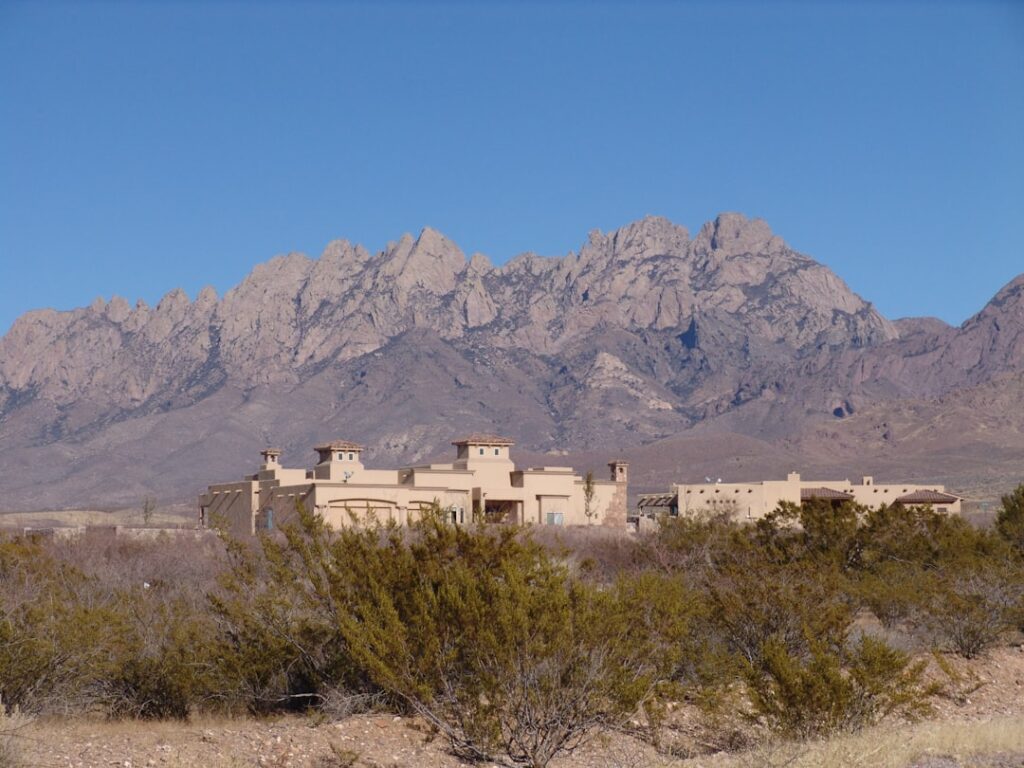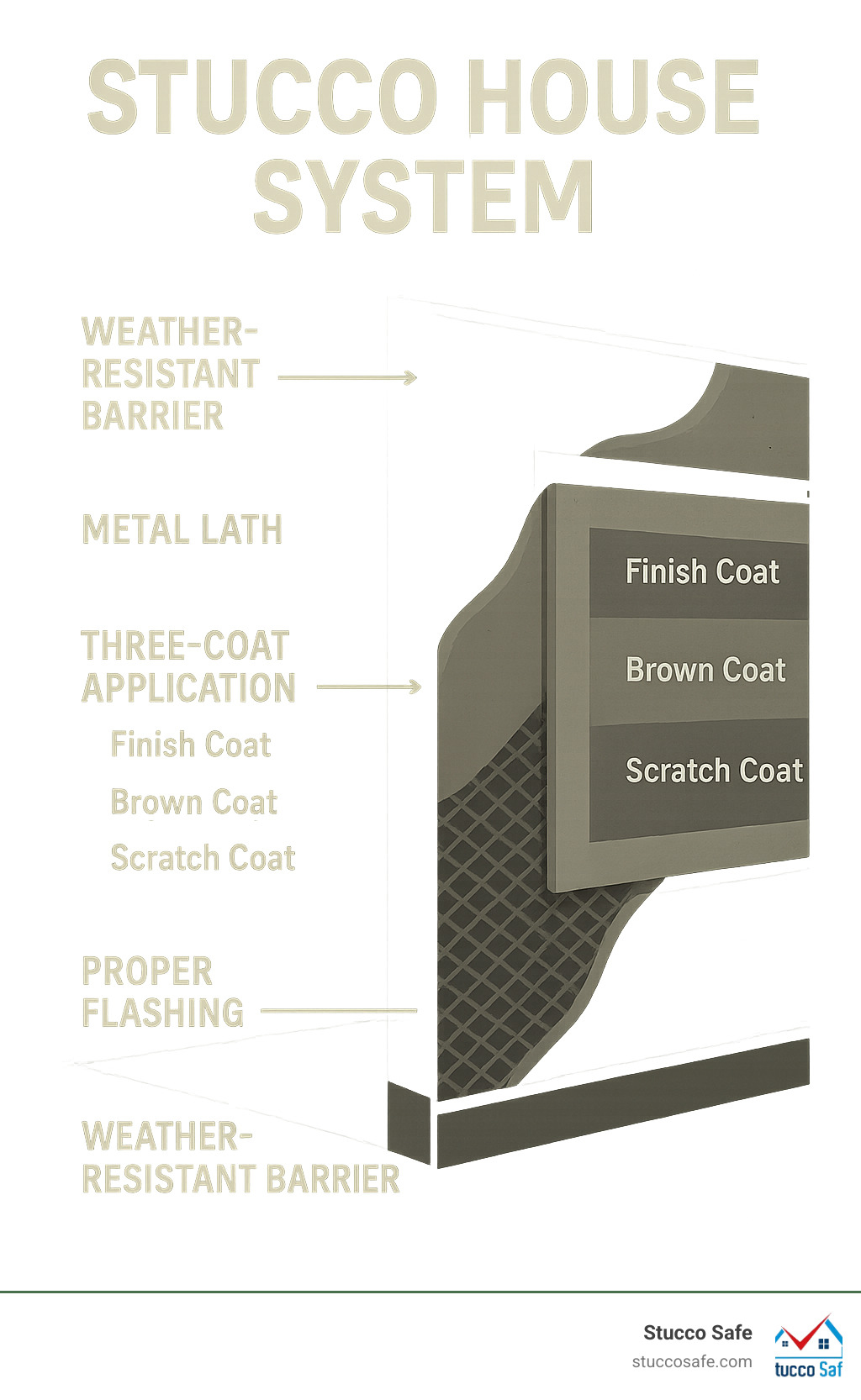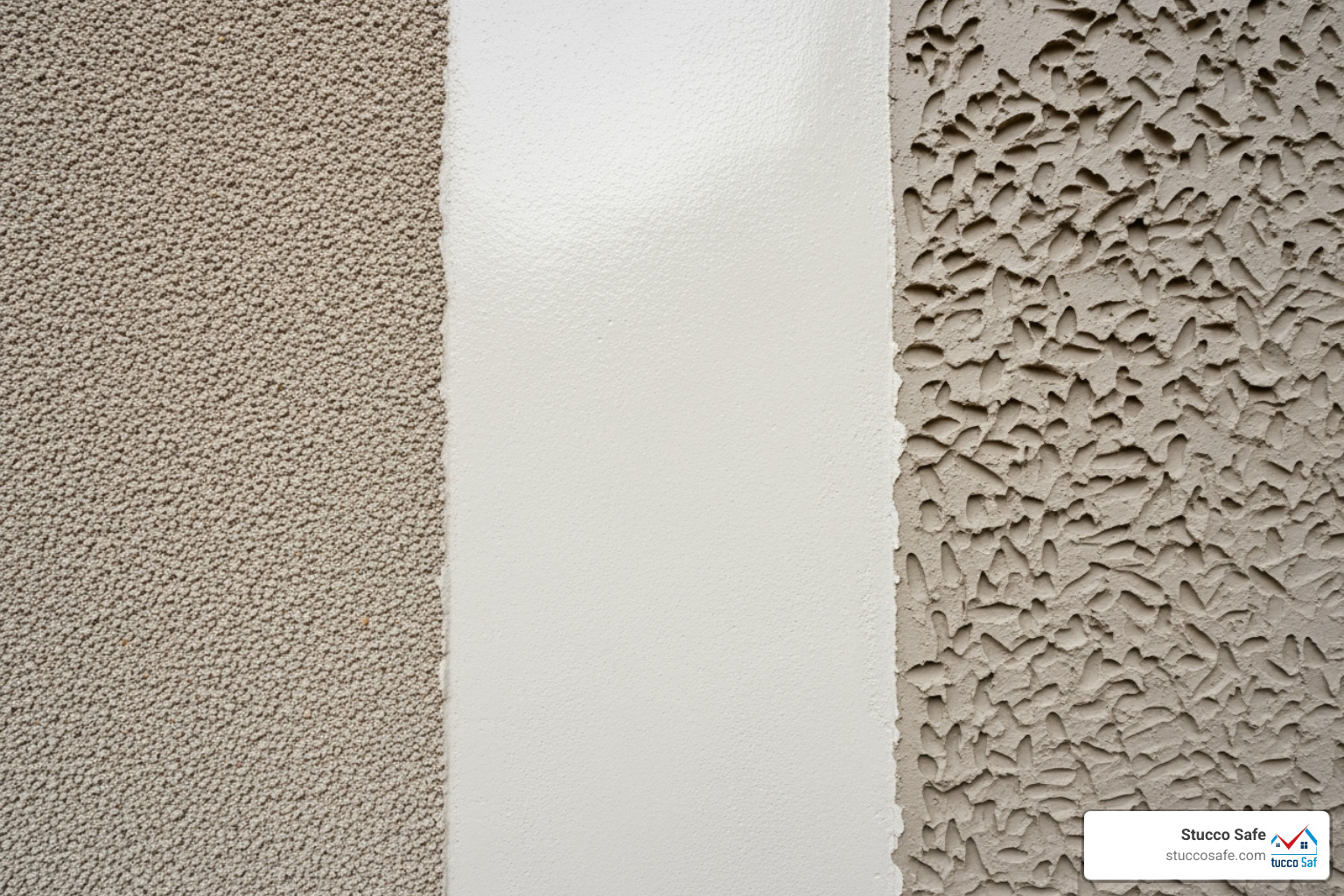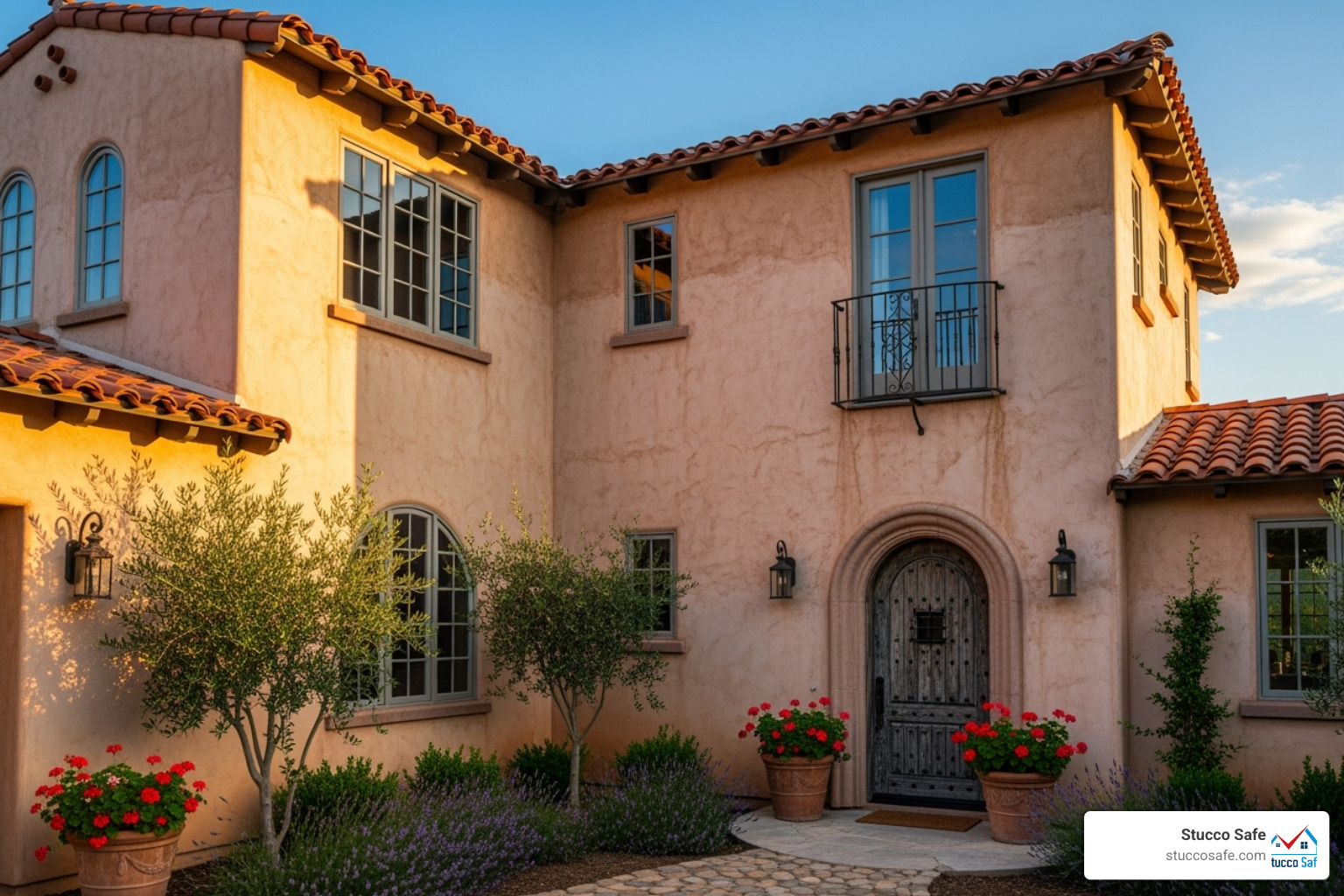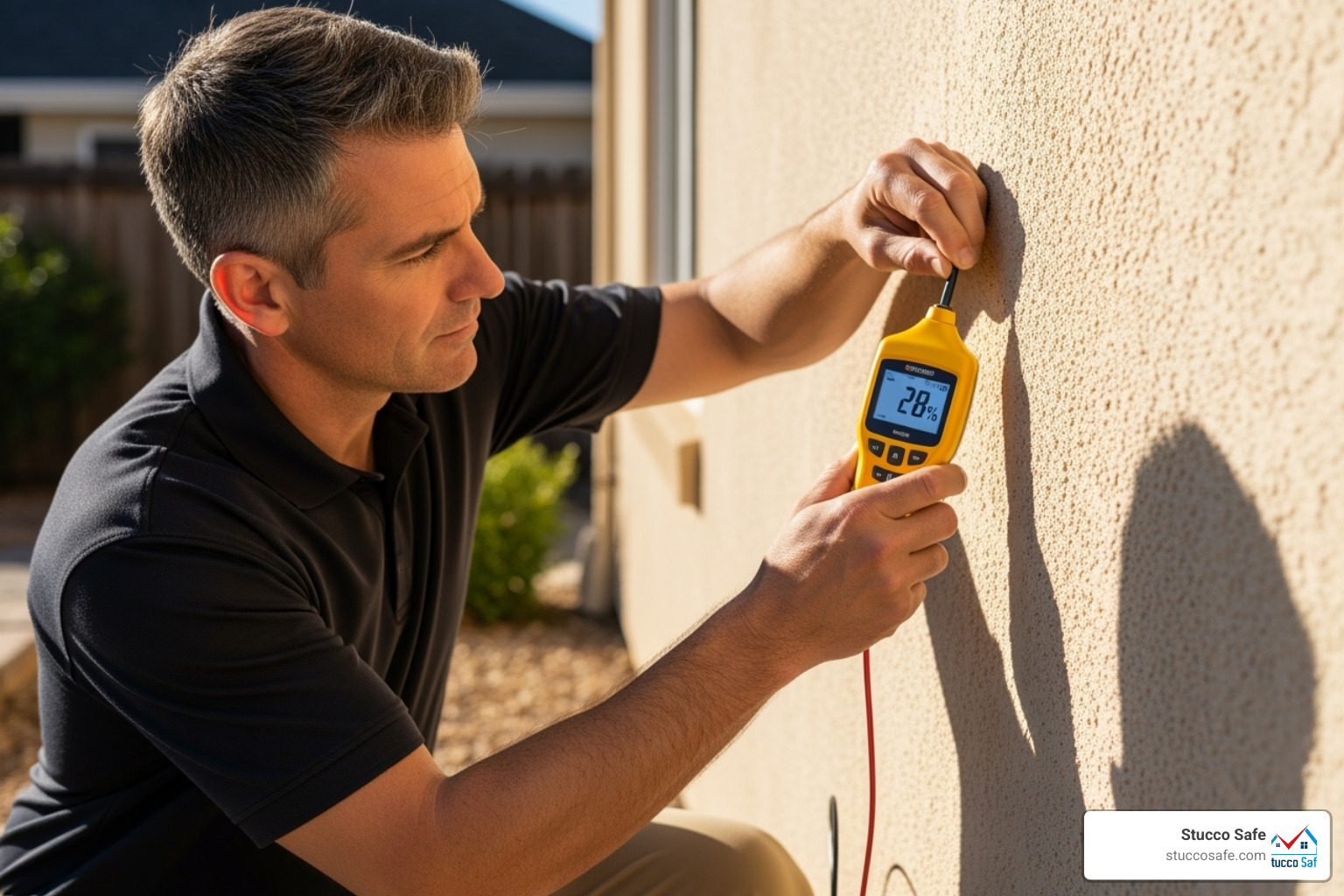Stucco House: Ultimate 2025 Guide
Why Stucco Houses Are America’s Second Most Popular Siding Choice
A stucco house has an exterior finish made from a cement-based mixture, creating a durable, seamless coating. This popular siding choice, found on nearly 29% of new homes, is known for its longevity and protective qualities.
Key Characteristics:
- Material: Portland cement, sand, lime, and water
- Application: Multiple coats over metal lath or masonry
- Durability: Can last 50-100 years with proper care
- Fire Resistance: Provides a one-hour firewall rating
When properly applied, stucco offers excellent weather protection for decades. However, a significant risk exists for homes built between 1993-2006, which have failure rates up to 90% due to flawed building codes. The primary concern is hidden moisture damage occurring behind the exterior finish, often invisible from the surface.
As certified stucco inspectors with over 20 years of experience in leak detection and building envelope forensics, we’ve helped thousands of homeowners identify these hidden issues, preventing costly repairs through early detection.
What is Stucco? Composition, Types, and Finishes
Stucco is an exterior plaster that creates a beautiful, seamless finish on homes. This building material, made from aggregates, a binder, and water, has been used for centuries to protect and decorate buildings. Today, modern stucco house exteriors primarily use two main types.
| Feature | Traditional Stucco (Hard-Coat) | Synthetic Stucco (EIFS – Exterior Insulation and Finish Systems) |
|---|---|---|
| Composition | Portland cement, sand, lime, water. | Acrylic polymers, resins, insulation board (foam), fiberglass mesh. |
| Application | Typically three coats (scratch, brown, finish) over lath or masonry. Applied directly to the substrate. | Applied in layers over an insulating foam board. Often a base coat with fiberglass mesh, and a finish coat. |
| Weight | Heavy (approx. 10 pounds per square foot). | Lighter (approx. 80% lighter than traditional). |
| Flexibility | Rigid, prone to cracking with building movement (settling, earthquakes). | Flexible, more resistant to cracking. |
| Insulation | Limited insulation value. | Excellent insulation value (at least twice that of traditional stucco). |
| Water Mgmt. | Breathable, allows moisture vapor to escape. Relies on a drain plane behind the stucco to manage water. | More water-resistant surface, but can trap moisture if water penetrates due to improper installation. |
| Cost | Generally less expensive for initial installation. | Often more expensive for initial installation. |
| Durability | Very durable when properly installed; can last 50-100 years. | Also durable, but performance heavily relies on perfect installation to prevent moisture issues. |
Traditional Stucco: The Classic Cement Mix
Traditional stucco is a time-tested mix of Portland cement, sand, lime, and water. This combination creates a hard, durable material that is also breathable. The lime content allows moisture vapor to escape, preventing buildup within the walls. When applied in the standard three-coat system over metal lath or masonry, it forms a strong, weather-resistant barrier that can last for generations.
Modern Synthetic Stucco (EIFS)
Synthetic stucco, or Exterior Insulation and Finish Systems (EIFS), uses acrylic polymers and resins instead of cement. This makes it more flexible and crack-resistant. EIFS is applied over an insulation board and reinforced with fiberglass mesh, giving it an insulation value at least twice that of traditional stucco. While its surface is more water-resistant, this property can also trap moisture if the system is improperly installed, making professional inspection critical.
Common Stucco Finishes and Textures
The final coat of stucco determines its texture and appearance, offering a wide range of aesthetic options for your stucco house.
- Sand Finish: A popular, subtly textured surface that comes in coarse, medium, or fine varieties. It’s great for hiding minor imperfections.
- Smooth Finish: A sleek, modern look that is troweled to a very smooth surface. It’s neat but shows imperfections and cracks more easily.
- Catface Finish: A smooth base with small, irregular raised areas, adding rustic character.
- Mission Finish: Also known as Santa Barbara finish, this provides a slightly rough, hand-crafted look perfect for Spanish or Mediterranean styles.
- Dash Finish: A rough, spattered texture created by throwing wet stucco onto the wall. It’s excellent for hiding surface irregularities.
Stucco can be colored during mixing or painted afterward, providing nearly unlimited color choices to match any home’s style.
The Pros and Cons of a Stucco House
Like any siding, stucco has significant benefits and potential challenges. The performance of a stucco house depends heavily on the quality of the installation and the regional climate. Understanding both sides helps you make an informed decision.
Advantages of Stucco Siding
A properly installed stucco house offers impressive advantages:
- Exceptional Durability: Stucco is a long-term investment, with a lifespan of 50 to 100 years or more. Historic stucco buildings have stood for centuries.
- Fire Resistance: Stucco provides a one-hour firewall rating, which can be life-saving in fire-prone areas by slowing the spread of flames.
- Design Versatility: Stucco creates a seamless finish that flows around architectural details. It can be customized with various textures and colors to achieve any look, from modern to classic.
- Pest and Rot Resistance: As an inorganic material, stucco is unappealing to termites and carpenter ants. It also does not rot or grow fungus like wood siding.
- Low Maintenance: When properly cared for, stucco doesn’t require frequent repainting and is easy to clean, saving time and effort.
Potential Disadvantages and Risks
It’s crucial to be aware of the potential downsides:
- Moisture Intrusion: This is the biggest risk. If installed without proper drainage planes and flashing, stucco can trap moisture, leading to hidden rot and structural damage. Homes built between 1993 and 2006 are especially vulnerable, with failure rates as high as 90 percent.
- Cracking: While hairline cracks from settling are normal, larger stress cracks can signal serious underlying issues. Traditional stucco is more rigid and prone to cracking than flexible synthetic systems.
- Porosity and Staining: Traditional stucco can absorb water, which may lead to staining from dirt, algae, or mineral deposits over time.
- Not DIY-Friendly: Stucco installation and major repairs require specialized skills and tools. Improper work often leads to costly, long-term problems.
For homeowners interested in preserving historic stucco, The Preservation and Repair of Historic Stucco offers valuable guidance.
Application and Long-Term Maintenance
The longevity of a stucco house depends on two things: professional installation and consistent maintenance. A strong start and ongoing care are essential.
The Professional Three-Coat Application Process
Proper stucco installation is a skilled craft. The traditional three-coat method ensures a durable and beautiful finish.
- Preparation: A weather-resistant barrier is applied over the home’s sheathing as a primary defense against moisture.
- Lath Installation: A metal lath (mesh) is fastened to the framing, creating a foundation for the stucco to grip.
- Scratch Coat: The first 3/8-inch layer of stucco is applied and then “scratched” to create a rough surface for the next coat to bond to.
- Brown Coat: The second 3/8-inch layer levels the surface and must cure properly.
- Finish Coat: The final, thinner layer provides the desired color and texture.
Proper curing time between each coat is critical. Rushing the process leads to weak, crack-prone stucco. The entire application can take a week or more.
Maintaining Your Stucco House Exterior
Stucco maintenance is straightforward with a proactive approach.
- Annual Inspections: Walk around your home yearly to check for cracks, stains, or damage. Early detection saves money.
- Gentle Cleaning: Use a garden hose on a low-pressure setting. For tough stains, use mild soap and a soft-bristle brush. Never pressure wash stucco, as it can force water into the wall system and cause damage.
- Gutter and Downspout Care: Keep gutters clean and ensure downspouts direct water away from the foundation to prevent staining and moisture exposure.
- Landscaping: Adjust sprinklers to avoid spraying walls directly. Trim shrubs and trees away from the house to prevent moisture trapping and surface damage.
Painting and Repairing Stucco
Painting can refresh your home’s look and add a layer of protection. Most stucco homes need repainting every five to seven years. Always wait at least 60 days for new stucco to cure before painting.
- Paint Choice: Use a 100% acrylic latex paint, which is durable and breathable, allowing moisture vapor to escape. Avoid non-breathable elastomeric paints, which can trap moisture and lead to serious damage.
- Crack Repair: Small hairline cracks can be sealed with a high-quality, paintable acrylic caulk before painting. For any crack wider than a quarter-inch, or if you see bulging or crumbling, call a professional. Improper DIY repairs can worsen the problem.
Key Considerations for Home Buyers and Owners
Whether buying or owning a stucco house, understanding its structural integrity and financial implications is key to a positive experience. All You Need to Know About Stucco Homes is a great resource for further reading.
Lifespan and Durability Factors
A well-built stucco house can last 50 to 100 years, but its longevity depends on several factors:
- Proper Installation: This is the most critical factor. A system lacking proper flashing, weep screeds, and a drainage plane will inevitably fail.
- Climate: Regions with frequent freeze-thaw cycles can cause damage if water penetrates the stucco and expands. Humid climates demand excellent moisture management.
- Foundation Stability: Significant foundation shifts can cause large stress cracks in the rigid stucco.
- Maintenance: Regular inspections, timely repairs, and proper cleaning are essential for a long lifespan.
- Water Management: Effective gutters, downspouts, and landscaping that directs water away from the foundation are vital. Weep screeds at the base of walls allow trapped moisture to escape.
Cost of Stucco Installation and Repairs
Understanding the costs helps in planning and decision-making.
- New Installation: A conventional stucco system on a 3,000 sq. ft. home costs around $20,000. Acrylic systems can cost $25,000 to $30,000. Per square foot, expect to pay $7 to $15.
- Cost Factors: Complex architectural details can increase costs by 10-25%, while multi-story homes requiring scaffolding can add 10-20%.
- Repairs: Minor patches may cost $150 to $500. Larger repairs can range from $400 to $1,100, with extensive damage costing $60 to $120 per square foot.
While a significant investment, stucco’s durability often makes it a worthwhile choice for long-term homeowners.
Why Professional Stucco Inspection is Crucial
A professional stucco inspection is a financial safety net for buyers and owners, given the history of moisture issues in stucco construction.
- Detecting Hidden Moisture: Stucco failures often cause damage behind the wall, invisible from the outside. By the time you see stains, significant structural rot may have occurred. An inspector can find moisture before it becomes a catastrophe.
- Identifying Improper Installation: A certified inspector can spot critical installation flaws (e.g., missing weep screeds, improper flashing) that a homeowner would miss.
- Protecting Your Investment: For buyers, an inspection can prevent the purchase of a home with hidden damage that could cost tens of thousands to remediate. For owners, it allows for early, less expensive repairs.
- Forensic Testing: Professionals use specialized tools and methods, such as drilling small, inconspicuous holes to get accurate moisture readings from the substrate behind the stucco. These holes are then sealed with matching caulk.
At Stucco Safe, our certified inspectors provide unbiased reports because we do not perform repairs, eliminating any conflict of interest. An inspection typically costs $495 to $1595, a small price for peace of mind.
Frequently Asked Questions about Stucco Homes
Here are straightforward answers to the most common questions about stucco house exteriors.
How long does a stucco house last?
A properly installed and maintained stucco house can last 50 to 100 years or more, outliving most other siding materials. The final lifespan depends on the quality of the initial installation, the local climate, and the consistency of maintenance and repairs.
Is stucco waterproof?
No, stucco is not waterproof; it is water-resistant. It is designed to be part of a complete wall system. The stucco sheds most water, but a weather-resistant barrier (like house wrap) underneath provides the actual waterproofing for your home’s structure. If this system is compromised by improper flashing or installation, water can get trapped behind the stucco and cause significant damage.
Can you pressure wash a stucco house?
It is highly recommended not to pressure wash a stucco house. The high pressure can damage the finish, force water into tiny cracks, and compromise the wall system, leading to the very moisture problems you want to avoid. Instead, clean with a gentle spray from a garden hose and use a soft-bristle brush with mild soap for stubborn dirt, rinsing thoroughly afterward.
Conclusion
A stucco house offers a blend of durability, fire resistance, and aesthetic versatility that has made it a popular choice for centuries. With a lifespan of 50 to 100 years, it’s a long-term investment in your home’s beauty and protection.
However, the greatest threat to any stucco system is hidden moisture. Poor installation, especially in homes built between 1993 and 2006, can lead to water intrusion that causes catastrophic damage behind a flawless-looking exterior. By the time you see a stain, the problem is often severe.
This is why professional oversight is non-negotiable. At Stucco Safe, we specialize in uncovering these hidden issues before they become disasters. Our certified inspectors use forensic testing methods to get accurate moisture readings from your home’s underlying structure. We provide unbiased, expert assessments because we don’t perform repairs—our only goal is to give you the facts.
For homeowners in Southeastern Pennsylvania, New Jersey, and Delaware, an inspection is a small investment for invaluable peace of mind. Protect your stucco house and your family’s largest asset with the expertise it deserves.
Learn more about ensuring your stucco house is safe and sound

